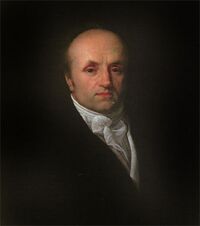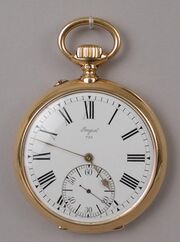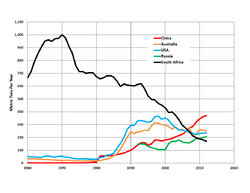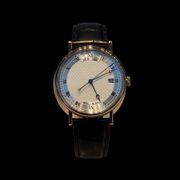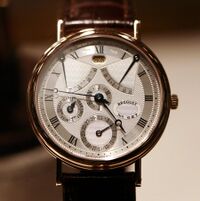Breguet (brand)
Topic: Company
 From HandWiki - Reading time: 12 min
From HandWiki - Reading time: 12 min
 | |
| Type | Subsidiary |
|---|---|
| Industry | Luxury watchmaking |
| Founded | 1775 |
| Founder | Abraham-Louis Breguet |
| Headquarters | L'Abbaye , Switzerland |
Area served | Worldwide |
Key people | Nicolas G. Hayek |
| Products | Watches, clocks, jewelry |
| Parent | The Swatch Group |
| Website | breguet |
Breguet is a luxury watch, clock and jewelry manufacturer founded by Abraham-Louis Breguet in Paris in 1775.[1] Since 1999, it has been a subsidiary of the Swiss Swatch Group.[2] Headquartered in L'Abbaye, Switzerland, Breguet is one of the oldest surviving watchmaking brands and a pioneer of numerous watchmaking technologies such as the tourbillon, which was invented by Abraham Breguet in 1801.[3] Abraham Breguet also invented and produced the world's first self-winding watch (the Perpétuelle) in 1780, as well as the world's first wristwatch in 1810 (the Breguet No.2639, for Caroline Bonaparte, Queen of Naples).[4][5][6]
Breguet is a highly regarded watch manufacturer.[1][7][8][9][10] Over the years, notable Breguet patrons and timepieces owners include King George III, Queen Victoria, Alexandre I of Russia, Napoléon Bonaparte, Ettore Bugatti, Sir Winston Churchill, Sergei Rachmaninoff, Gioachino Rossini, Arthur Rubinstein and so on.[11][12][13] In particular, the Breguet & Fils, Paris No. 2667 (1814) pocket watch ranks as one of the world's most expensive watches ever sold at auction, fetching US$4.69 million (CHF 4,339,000) in Geneva in May 2012.[14][15] The Breguet Sympathique Clock No.128 & 5009 (Duc d'Orléans Breguet Sympathique), on the other hand, currently holds the title of the most expensive Breguet timepiece ever sold at auction, fetching US$6.80 million in New York in December 2012.[16][17][18]
History
Early history
Breguet was founded in 1775 by Abraham-Louis Breguet, a Swiss watchmaker born to Huguenot parents in Neuchâtel. He studied watchmaking for ten years under Ferdinand Berthoud and Jean-Antoine Lépine before setting up his own watchmaking business at 51 Quai de l'Horloge on the Île de la Cité in Paris. The dowry that came with his marriage to the daughter of a prosperous French bourgeois provided the backing which allowed him to open his own workshop.
Breguet's connections made during his apprenticeship as a watchmaker and as a student of mathematics helped him to establish his business. Following his introduction to the court, Queen Marie Antoinette grew fascinated by Breguet's unique self-winding watch; Louis XVI bought several of his watches. In 1783 the Swedish count Axel Von Fersen, who was the queen's friend and reputed lover, commissioned a watch from Breguet that was to contain every watch complication known at that time as a gift to Marie Antoinette. The result is a Breguet's masterpiece, the Marie-Antoinette pocket watch (Breguet No.160).[19][20]
The business was a success, and around 1807 Abraham-Louis Breguet took on his son Louis-Antoine as his partner, renaming the firm "Breguet et Fils" (Breguet and Sons). Louis-Antoine took over the firm upon the death of his father in 1823. After Louis-Antoine retired in 1833 (he died in 1858) the business was passed to Abraham-Louis' grandson Louis Clément Francois (1804–1883).
Abraham-Louis' great-grandson Louis Antoine (1851–1882) was the last of the Breguet family to run the business. Although he had two sons and a daughter, they did not enter the business, so the Breguet company hired noted English watchmaker Edward Brown of Clerkenwell to manage the Paris factory. Brown eventually became a partner and, after Breguet's grandson's death, the owner and head of the company. When Brown died in 1895 the firm was taken over by his sons, Edward and Henry. On Edward's retirement in the early 1900s, Henry Brown became the head of the firm.[21]
Recent development
From 1870 to 1970, Breguet was owned by the English Brown family. But the ownership changed hands several times during the quartz crisis in the 1970s and 1980s. In 1976, Breguet's then-owner Chaumet closed its French factory and moved production to the Vallée de Joux in Switzerland.
In 1987, Breguet was acquired by Investcorp which, in 1991, created the Groupe Horloger Breguet (GHB). The Breguet Group consists of four subsidiaries: Montres Breguet SA, Breguet SA, Valdar SA and Nouvelle Lemania SA (which Breguet Group acquired in 1992).[2][22] As a result, Breguet-brand watches are now made at the Nouvelle Lemania factory in Switzerland. In particular, Montres Breguet SA is the main company that sells timepieces under the brand name of "Breguet", and Breguet SA is the name of Breguet Group's distribution company in France.[2]
In 1999, Groupe Horloger Breguet was acquired by the Swatch Group from Investcorp.[2] Breguet is an active member of the Federation of the Swiss Watch Industry FH.[23]
Motto and slogan
One of Breguet's company mottoes is "In every woman is a queen."[24][25] The motto was introduced for Breguet's lady's collection, the Reine de Naples collection.[25]
Watch manufacturing
Breguet watches are often easily recognized for their coin-edge cases, guilloché dials and blue pomme hands (often now referred to as 'Breguet hands').[26] In addition to watches, Breguet also manufactures writing instruments, women's jewelry, and cufflinks.[27]
Notable inventions and patents
The following are some of the important inventions of Abraham-Louis Breguet and Breguet company.
- In 1780, invented and produced the world's self-winding/automatic watch (the Perpétuelle).[4][5]
- In 1783, invented the Gong-spring, laying the foundation for minute repeaters.[28][29]
- In 1783, invented the Breguet hands.[30][31]
- In 1790, invented the Pare-chute, one of the world's first shock protection systems.[32][33]
- In 1795, invented the Breguet overcoil or Breguet spiral, being widely used in watchmaking industry to this day.[34][35]
- In 1801, invented tourbillon, balancing the effect of gravity.[3]
- In 1810, invented and produced the world's first wristwatch (Breguet No. 2639).[6][36]
- In 1929, created the world's first (possibly) perpetual calendar movement for wristwatches (Breguet No. 2516).[37][38][39]
- In 2010, patented the magnetic pivot, used to improve watch precision using magnetism.[40]
- In 2010, introduced the magnetic strike governor.[41]
Environmental rating
In December 2018, World Wide Fund for Nature (WWF) released an official report giving environmental ratings for 15 major watch manufacturers and jewelers in Switzerland.[42][43] Breguet, along with 7 other manufacturers including Patek Philippe, Audemars Piguet and Rolex, was given the lowest environmental rating as "Latecomers/Non-transparent", suggesting that the manufacturer has taken very few actions addressing the impact of its manufacturing activities on the environment and climate change.[42]
There are concerns over the lack of transparency in manufacturing activities and the sourcing of precious raw materials such as gold, which is a major cause of environmental issues such as pollution, soil degradation and deforestation.[42][43] The situation is especially serious in the developing countries which are top producers of gold, including China, Russia and South Africa.[44][45][46][47] It is estimated that the watch and jewelry sector uses over 50% of world's annual gold production (over 2,000 tons), but in most cases the watch companies are not able to or are unwilling to demonstrate where their raw materials come from and if the material suppliers use eco-friendly sourcing technologies.[42]
Notable models
Most expensive pieces
- In May 2012, a Breguet pocket watch, the Breguet & Fils, Paris No.2667, was sold in Christie's Geneva auction with a final price of US$4.69 million (CHF 4,339,000).[48][49]
- In May 2012, a Breguet pocket watch, the Breguet, Paris, No.4111, was sold in Christie's Geneva auction with a final price of US$2.75 million (CHF 2,547,000).[50][51]
- In December 2012, the Breguet Sympathique Clock No.128 & 5009 (Duc d'Orléans Breguet Sympathique, owned by Ferdinand Philippe, Duke of Orléans) was auctioned by Sotheby's for US$6.8 million in New York, making it the most expensive Breguet timepiece ever sold at auction.[16][17] The clock was auctioned by Sotheby's for the first time in 1999, fetching a record-breaking US$5,777,500 in New York, after the shutdown of the celebrated Time Museum in Rockford, Illinois.[52]
- In May 2016, a pocket watch, the Breguet & Fils, No.217, was sold in Christie's Geneva auction for US$3.33 million (CHF 3,245,000).[53][54]
Marie-Antoinette pocket watch
The final product was the Breguet No.160 grand complication (Marie-Antoinette pocket watch). However, the watch was only finished in 1827, 34 years after the death of the Queen during French Revolution , and four years after the death of Abraham-Louis Breguet (the watch was eventually completed by the son of Abraham Breguet).[19][55] In total, it took 44 years to make the watch.[19][55]
The watch had been kept in the Museum for Islamic Art in Jerusalem until it was stolen in 1983.[19][56] In 2007, the watch was eventually recovered and returned to the museum.[19][56]
Gentleman's collection
- Classique: Simple, Grandes Complications – popular round pieces, usually with reeded casebands and soldered lugs;
- La Marine – water-resistant, distinguished by the presence of crown guards;
- Heritage – tonneau-shaped cases;
- Type XX, XXI, XXII – sports chronographs, based on World War II-era pilots' watches;
- The Type XXII Flyback Chronograph, available in rose gold.[59]
- Tradition – similar to the long gone Souscription by Breguet, open-faced watches with the movement on the front, along with a small face.
Lady's collection
- Classique;
- La Marine;
- Heritage;
- Type XX;
Reine de Naples – oval bezels.
Notable patrons and owners
Artists
- Alexander Pushkin, Russian poet[60]
- Giovanni Paisiello, Italian composer[13]
- Sergei Rachmaninoff, Russian composer[13][61]
- Gioachino Rossini, Italian composer[62]
- Arthur Rubinstein, Polish-American pianist[63]
- Horace Vernet, French painter[13]
Entrepreneurs
Intellectuals
- Marquis de Condorcet, French philosopher and mathematician[13][65]
Politicians
- Nicolas Sarkozy, 23rd President of France [66][67]
- Charles Maurice de Talleyrand, Prime Minister of France [68]
- Michel Ney, Marshal of France[69]
- Vladimir Putin, President of Russia [70][71]
- Dmitry Medvedev, Prime Minister of Russia[72]
- Sir Winston Churchill, Prime Minister of the United Kingdom , 1953 Nobel Literature Prize winner[73][74]
- 1st Duke of Wellington, Prime Minister of the United Kingdom[13][75]
Royalty
- Fuad I of Egypt, King of Egypt[13][76]
- Farouk of Egypt, King of Egypt[77]
- Napoléon Bonaparte, Emperor of France[78]
- Empress Joséphine, first Empress of France[79]
- Marie Louise, Duchess of Parma, second Empress of France[13]
- Louis XVI and Marie Antoinette, King and Queen of France[80][81]
- Louis XVIII, King of France[13]
- Caroline Bonaparte, Queen of Naples[82]
- Selim III, Sultan of Ottoman Empire[83]
- Alexandre I, Tsar of Russia[12]
- George III, King of the United Kingdom[13][84]
- George IV, King of the United Kingdom[13][85]
- Queen Victoria, Queen of the United Kingdom[86]
- Edward VIII, King of the United Kingdom and Duke of Windsor[13]
See also
References
- ↑ 1.0 1.1 "Brand - Fondation de la Haute Horlogerie". https://www.hautehorlogerie.org/en/brands/brand/h/breguet/.
- ↑ 2.0 2.1 2.2 2.3 "The Swatch Group Ltd. acquires Groupe Horloger Breguet from Investcorp S.A.". http://www.swatchgroup.com/en/services/archive/1999/the_swatch_group_ltd_acquires_groupe_horloger_breguet_from_investcorp_s_a. Retrieved 3 October 2014.
- ↑ 3.0 3.1 "Tourbillon | Breguet". https://www.breguet.com/en/history/inventions/tourbillon.
- ↑ 4.0 4.1 "Abraham-Louis Breguet | Timepiece Luminaries | THE SEIKO MUSEUM". https://museum.seiko.co.jp/en/knowledge/episode/episode_03/.
- ↑ 5.0 5.1 "Self-winding | Breguet". https://www.breguet.com/en/history/inventions/self-winding.
- ↑ 6.0 6.1 "First wristwatch | Breguet". https://www.breguet.com/en/history/inventions/first-wristwatch.
- ↑ "Marking time: one watchmaker’s literary tributes" (in en-GB). The Telegraph. 2017-06-14. ISSN 0307-1235. https://www.telegraph.co.uk/culture/breguet-luxury-watches/breguet-in-films-and-literary-tributes/.
- ↑ "Breguet: the Expression of Being – FHH Journal" (in en-US). https://journal.hautehorlogerie.org/en/breguet-the-expression-of-being/.
- ↑ Clymer, Benjamin (14 January 2016). "A Week On The Wrist: The Breguet Classique Chronométrie 7727" (in en). https://www.hodinkee.com/articles/the-breguet-classique-chronometrie-7727.
- ↑ "Breguet Ranked Most Prestigious Among Pentamillionaires" (in en). 2012-06-06. https://www.luxury-insider.com/luxury-news/2012/06/breguet-ranked-most-prestigious-among-pentamillionaires.
- ↑ "Distinguished Patrons (1824 - 1863) Timeline | Breguet". https://www.breguet.com/en/timeline/1824-1863/distinguished-patrons.
- ↑ 12.0 12.1 "1809 - Alexandre 1st, Tsar of Russia (Timeline of Breguet)". https://www.breguet.com/en/timeline/1801-1823/distinguished-patrons/alexandre-1st-tsar-russia-7121.
- ↑ 13.00 13.01 13.02 13.03 13.04 13.05 13.06 13.07 13.08 13.09 13.10 13.11 13.12 "THE BREGUET COLLECTIONS". https://www.breguet.com/sites/default/files/edition/Breguet_Catalogue_2017_web_EN.pdf.
- ↑ "Christie's - Record Price For Any Breguet Watch - Business - WorldTempus" (in en). http://en.worldtempus.com/article/industry-news/business/christies-record-price-for-any-breguet-watch-12598.html.
- ↑ "Important Watches" (in en). https://www.christies.com/Important-Watches-23897.aspx.
- ↑ 16.0 16.1 "The Duc d'Orléans Breguet Sympathique". http://www.sothebys.com/en/auctions/ecatalogue/2012/important-watches-n08882/lot.124.html.
- ↑ 17.0 17.1 DeMarco, Anthony. "Rare Breguet Clock Sells For Record $6.8 Million" (in en). https://www.forbes.com/sites/anthonydemarco/2012/12/05/rare-breguet-clock-sell-for-record-6-8-million/.
- ↑ "Breguet Clock With Docking Pocket Watch Re-Sets Record For A Clock At Auction, Fetching $6.8 Million at Sotheby's New York" (in en). 5 December 2012. https://www.hodinkee.com/articles/breguet-clock-docking-pocket-watch-record-sothebys-new-york.
- ↑ 19.0 19.1 19.2 19.3 19.4 Cite error: Invalid
<ref>tag; no text was provided for refs named:0 - ↑ Cite error: Invalid
<ref>tag; no text was provided for refs named:3 - ↑ Salomons, 1921, pp.7–8
- ↑ "Company Overview of Groupe Horloger Breguet". https://www.bloomberg.com/research/stocks/private/snapshot.asp?privcapid=944327.
- ↑ "Our brands". https://www.fhs.swiss/eng/watch_brands.html?letter=B.
- ↑ "Swatch Group Annual Report 2012". https://www.swatchgroup.com/sites/default/files/media-files/2012_annual_report_complete_en.pdf.
- ↑ 25.0 25.1 "Watches ad In every woman is a queen for Breguet" (in en-US). https://www.afaqs.com/advertising/creative_showcase/index.html?id=64200&media=Print&type=Indian.
- ↑ "Breguet hands | Breguet". https://www.breguet.com/en/history/inventions/breguet-hands.
- ↑ "Breguet Collecstions.". Archived from the original on 6 October 2014. https://web.archive.org/web/20141006161758/http://www.breguet.com/Collections. Retrieved 3 October 2014.
- ↑ "Gong-spring | Breguet". https://www.breguet.com/en/history/inventions/gong-spring.
- ↑ "Gong Chimes and Grand Traditions" (in en-US). https://www.calibremagazine.com/story/gong-chimes-and-grand-traditions/.
- ↑ "Breguet hands | Breguet". https://www.breguet.com/en/history/inventions/breguet-hands.
- ↑ "Breguet hands | Breguet". https://www.breguet.com/en/house-breguet/unmistakable-signs/breguet-hands.
- ↑ "Pare-chute | Breguet". https://www.breguet.com/en/history/inventions/pare-chute.
- ↑ Contributor. "The Basics Of Shock Resistance | Crown Watch Blog" (in en-gb). http://www.crownwatchblog.com/how-it-works/the-basics-of-shock-resistance.
- ↑ "Breguet balance-spring | Breguet". https://www.breguet.com/en/history/inventions/breguet-balance-spring.
- ↑ "Breguet overcoil - Fondation de la Haute Horlogerie". https://www.hautehorlogerie.org/en/encyclopaedia/glossary-of-watchmaking/s/breguet-overcoil-1/.
- ↑ "Histoire de la Maison Breguet" , Tendance Horlogerie, 16 April 2009 (French)
- ↑ "Breguet. A unique and historically important 18K white gold tonneau-shaped wristwatch with instantaneous perpetual calendar and moon phases , SIGNED BREGUET, NO. 2516, MANUFACTURED IN 1929" (in en). https://www.christies.com/lotfinder/lot_details.aspx?intObjectID=5431276.
- ↑ "The Perpetual Calendar Complication: A History" (in en-US). 2018-06-21. https://blog.crownandcaliber.com/the-perpetual-calendar-complication-a-history/.
- ↑ Touchot, Arthur (29 February 2016). "Historical Perspectives: (Possibly) The World's First Perpetual Calendar Wristwatch, From Breguet, Revisited On Leap Day 2016" (in en). https://www.hodinkee.com/articles/the-first-instantaneous-perpetual-calendar-movement-made-for-a-wristwatch-possibly.
- ↑ "Magnetic pivot | Breguet". https://www.breguet.com/en/history/inventions/magnetic-pivot.
- ↑ "Magnetic strike governor | Breguet". https://www.breguet.com/en/history/inventions/magnetic-strike-governor.
- ↑ 42.0 42.1 42.2 42.3 "Environmental rating and industry report 2018". https://www.wwf.ch/sites/default/files/doc-2018-12/2018_12_07_WWF%20Watch%20and%20Jewellery%20Report%202018_final_e_0.pdf.
- ↑ 43.0 43.1 swissinfo.ch, S. W. I.; Corporation, a branch of the Swiss Broadcasting. "Swiss luxury watches fail to meet environmental standards" (in en). https://www.swissinfo.ch/eng/politics/benchmark-report_swiss-luxury-watches-fail-to-meet-environmental-standards/44628536.
- ↑ Vidal, John; Guest, graphic by Pete (2015-08-15). "How developing countries are paying a high price for the global mineral boom" (in en-GB). The Observer. ISSN 0029-7712. https://www.theguardian.com/global-development/2015/aug/15/developing-countries-high-price-global-mineral-boom.
- ↑ "China needs to get to grips with its gold mining pollution crisis" (in en). https://www.chinadialogue.net/article/show/single/en/6996-China-needs-to-get-to-grips-with-its-gold-mining-pollution-crisis.
- ↑ Einhorn, Dom (2015-02-09). "Mining in Russia: An economic boost or an environmental threat?" (in en-US). https://born2invest.com/articles/mining-in-russia-an-economic-boost-or-an-environmental-threat/.
- ↑ "South Africa has failed to protect locals from gold mine pollution: Harvard report" (in en). 2016-10-12. http://www.mining.com/south-africa-has-failed-to-protect-locals-from-gold-mine-pollution-harvard-report/.
- ↑ "Breguet & Fils, Paris, No. 2667" (in en). https://www.christies.com/lotfinder/Lot/breguet-fils-paris-no-2667-montre-5553702-details.aspx.
- ↑ "Important Watches" (in en). https://www.christies.com/Important-Watches-23897.aspx.
- ↑ "Breguet shines at the Geneva auctions in May – FHH Journal" (in en-US). https://journal.hautehorlogerie.org/en/breguet-shines-at-the-geneva-auctions-in-may/.
- ↑ "Patek Philippe (REF. 2499, MOVEMENT NO. 868'019, CASE NO. 687'772, MANUFACTURED IN 1950)" (in en). https://www.christies.com/lotfinder/Lot/patek-philippe-an-exceptionally-fine-and-rare-5553556-details.aspx.
- ↑ "RECORD-BREAKING $11 MILLION WATCH SELLS AT SOTHEBY'S PROVING THAT TIME IS MONEY". https://sothebys.gcs-web.com/static-files/174cdeed-27af-489d-b9d5-ba3aac4b240e.
- ↑ "Breguet (No. 217 , SIGNED BREGUET ET FILS, SOLD IN GERMINAL AN 8 (1800) TO GÉNÉRAL MOREAU FOR THE SUM OF 3,600 FRANCS, RESOLD TO MR. HAVAS ON 31ST DECEMBER 1817 FOR 4,800 FRANCS)" (in en). https://www.christies.com/LotFinder/lot_details.aspx?intObjectID=5992914.
- ↑ "GLOBAL RESULTS FOR WATCH AUCTIONS IN 2016 | AderWatches" (in en-GB). AderWatches. 2017-01-31. https://aderwatches.com/en/blog/the-markets-eye/global-results-for-watch-auctions-in-2016/.
- ↑ 55.0 55.1 Cite error: Invalid
<ref>tag; no text was provided for refs named:1 - ↑ 56.0 56.1 Bell, Rebekah (2015-12-02). "The Breguet That Got Away: History's Greatest Watch Heist" (in en). https://robbreport.com/style/watch-collector/breguet-got-away-historys-greatest-watch-heist-230103/.
- ↑ "Insider: Breguet Classique Tourbillon Extra-Flat ref. 5367" (in en-US). https://www.watchcollectinglifestyle.com/home/breguet-classique-tourbillon-extra-flat-ref-5367-review.
- ↑ "Insider: Breguet Classique Small Seconds ref. 7147. Hands-on with a Very Slim and Super Elegant 'Time Only' Watch." (in en-US). https://www.watchcollectinglifestyle.com/home/insider-breguet-classique-small-seconds-ref-7147-hands-on-with-a-very-slim-and-super-elegant-time-only-watch.
- ↑ "Insider: Breguet Type XXII Flyback Chronograph ref. 3880. Equipped with a 10Hz High Frequency Movement and Just the Right Amount of Red." (in en-US). https://www.watchcollectinglifestyle.com/home/insider-breguet-type-xxii-flyback-chronograph-ref-3880-equipped-with-a-10hz-high-frequency-movement-and-just-the-right-amount-of-red.
- ↑
"Error: no
|title=specified when using {{Cite web}}". https://www.breguet.com/en/history/timeline/writers/alexandre-pouchkine. - ↑ "Breguet Lends its Support to the Geneva International Music Competition | Breguet". https://www.breguet.com/en/house-breguet/partnerships/breguet-lends-its-support-geneva-international-music-competition.
- ↑ "Gioachino Rossini". https://www.breguet.com/en/timeline/1824-1863/distinguished-patrons/gioachino-rossini-11015.
- ↑ "1903 - Arthur Rubinstein (Timeline of Breguet)". https://www.breguet.com/en/timeline/1864-1969/distinguished-patrons/arthur-rubinstein-7193.
- ↑ "News: Breguet Acquires a Dashboard Chronograph Specially Created for Bugatti. Meet The Breguet No. 2023." (in en-US). https://www.watchcollectinglifestyle.com/home/news-breguet-acquires-a-dashboard-chronograph-specially-created-for-bugatti-meet-the-breguet-no-2023.
- ↑ Mun-Delsalle, Y.-Jean. "Million-Dollar Babies: 10 Bling-Free Watches Priced At More Than A Million Dollars" (in en). https://www.forbes.com/sites/yjeanmundelsalle/2016/08/13/million-dollar-babies-10-bling-free-watches-priced-at-more-than-a-million-dollars/.
- ↑ Novela, Daniel (22 February 2013). "Power, And the Watch" (in en-US). https://www.hautetime.com/power-and-the-watch/18683/.
- ↑ Samuel, Henry (2007-11-12). "Sarkozy ticking as Geneva goes watch crazy" (in en-GB). Daily Telegraph. ISSN 0307-1235. https://www.telegraph.co.uk/news/worldnews/1569125/Sarkozy-ticking-as-Geneva-goes-watch-crazy.html.
- ↑ "1787 - Charles Maurice de Talleyrand (Timeline of Breguet)". https://www.breguet.com/en/timeline/1747-1800/distinguished-patrons/charles-maurice-de-talleyrand-7064.
- ↑ "1813 - Michel Ney, marshal of France (Timeline of Breguet)". https://www.breguet.com/en/timeline/1801-1823/distinguished-patrons/michel-ney-marshal-france-7136.
- ↑ "Putin's Flashy $700K Watch Collection" (in en). https://abcnews.go.com/blogs/headlines/2012/06/putins-extravagant-700000-watch-collection/.
- ↑ Rickett, Oscar (2013-09-17). "Why Does Vladimir Putin Keep Giving His Watches Away to Peasants?" (in en-US). https://www.vice.com/en_us/article/5gkzzq/putin-flaunting-his-watch-collection-is-just-another-display-of-power.
- ↑ "Medvedev: I'm No Millionaire" (in en). 2009-04-06. https://www.thedailybeast.com/cheats/2009/04/06/medvedev-irsquom-no-millionaire.
- ↑ "1901 - Sir Winston Churchill (Timeline of Breguet)". https://www.breguet.com/en/timeline/1864-1969/distinguished-patrons/sir-winston-churchill-7185.
- ↑ "Churchill's Breguet watch recreated for Darkest Hour – FHH Journal" (in en-US). https://journal.hautehorlogerie.org/en/churchills-breguet-watch-recreated-for-darkest-hour/.
- ↑ "How did the Duke of Wellington acquire the watch worn by Napoleon's brother?" (in en-GB). The Telegraph. 2017-03-08. ISSN 0307-1235. https://www.telegraph.co.uk/culture/breguet-luxury-watches/a-watch-won-at-waterloo/.
- ↑ "Breguet. A fine and rare lady’s platinum, enamel, diamond and emerald-set rectangular wristwatch with certificate, made for King Fouad I of Egypt , SIGNED BREGUET, NO. 773, MADE IN 1925" (in en). https://www.christies.com/lotfinder/lot_details.aspx?intObjectID=6102736.
- ↑ "King Farouk's Breguet, No. 1880/24071. Presentation watch specially made for King Farouk, circa 1935.". catalog.antiquorum.swiss. https://catalog.antiquorum.swiss/en/lots/breguet-lot-144-98?browse_all=1&page=1&q=king+farouk. Retrieved 2019-02-24.
- ↑ "1798 - Napoléon Bonaparte (Timeline of Breguet)". https://www.breguet.com/en/timeline/1747-1800/distinguished-patrons/napol%C3%A9on-bonaparte-7049#.
- ↑ "1798 - L'impératrice Joséphine (Timeline of Breguet)". https://www.breguet.com/en/timeline/1747-1800/distinguished-patrons/limp%C3%A9ratrice-jos%C3%A9phine-7075.
- ↑ "Abraham-Louis Breguet | Breguet". https://www.breguet.com/en/house-breguet/personalities/abraham-louis-breguet.
- ↑ "1782 - Queen Marie-Antoinette (Timeline of Breguet)". https://www.breguet.com/en/timeline/1747-1800/distinguished-patrons/queen-marie-antoinette-7007.
- ↑ "1808 - Caroline Murat, Queen of Naples (Timeline of Breguet)". https://www.breguet.com/en/timeline/1801-1823/distinguished-patrons/caroline-murat-queen-naples-7104.
- ↑ "1804 - Selim III (Timeline of Breguet)". https://www.breguet.com/en/timeline/1801-1823/distinguished-patrons/selim-iii-7088.
- ↑ Lucas, Edward Verrall (1922) (in en). Giving and Receiving: Essays and Fantasies. G. H. Doran. https://books.google.com/books?id=KqkKAAAAYAAJ&q=george+iii+breguet+watch&pg=PA75.
- ↑ "Breguet (AN EARLY GOLD AND SILVER SOUSCRIPTION WATCH NO 3233 SOLD TO MONSIEUR LE DUC D' ARGYLE 30 SEPTEMBER 1818 FOR 678 FRANCS)". http://www.sothebys.com/en/auctions/ecatalogue/2012/important-watches/lot.348.html.
- ↑ "1838 - Queen Victoria (Timeline of Breguet)". https://www.breguet.com/en/timeline/1824-1863/distinguished-patrons/queen-victoria-7170.
External links
- Official site
- Breguet watches in the Hermitage Museum
- The history of Breguet (Time and Watches)
- Breguet 1747–1823 – online edition of the seminal 1921 biography by Sir David Salomons, hosted by Archive.org
 KSF
KSF